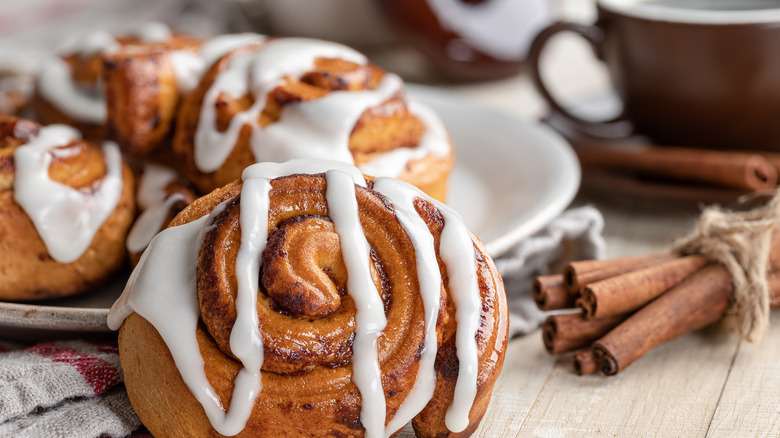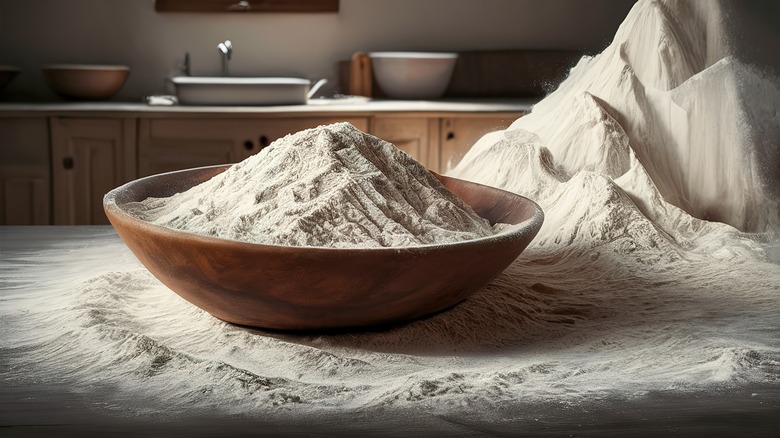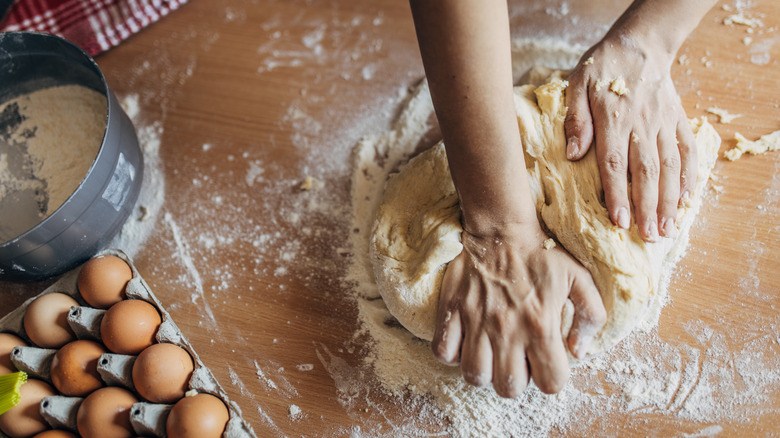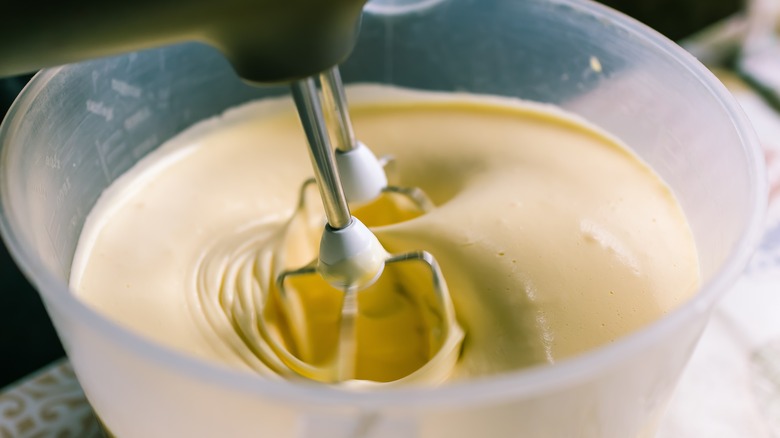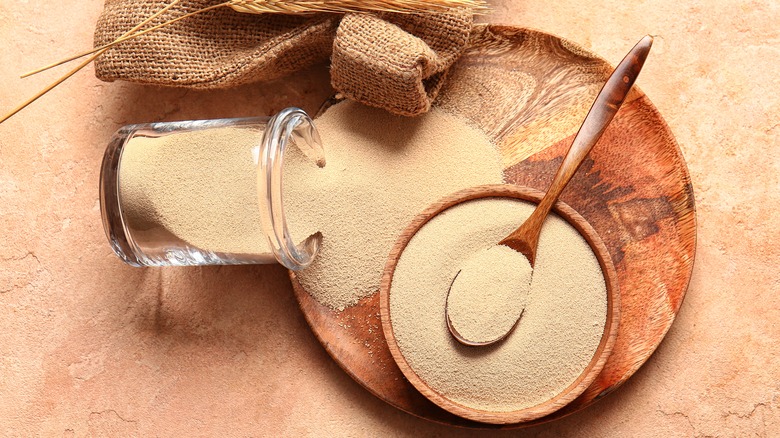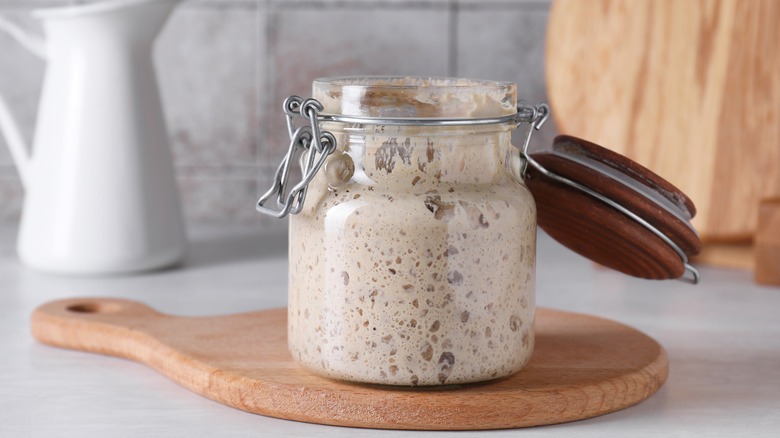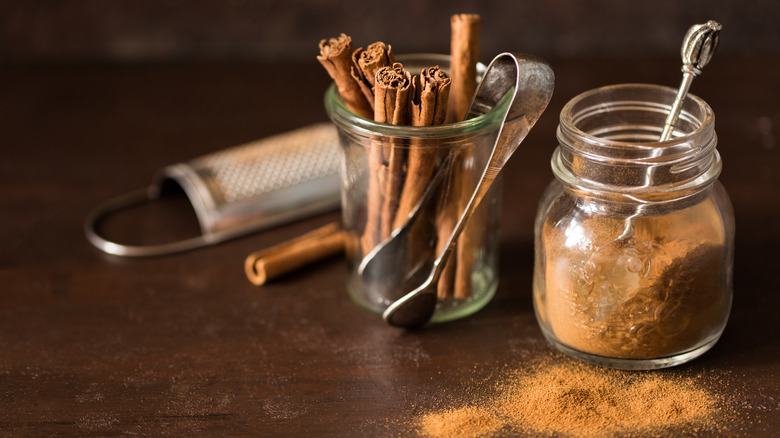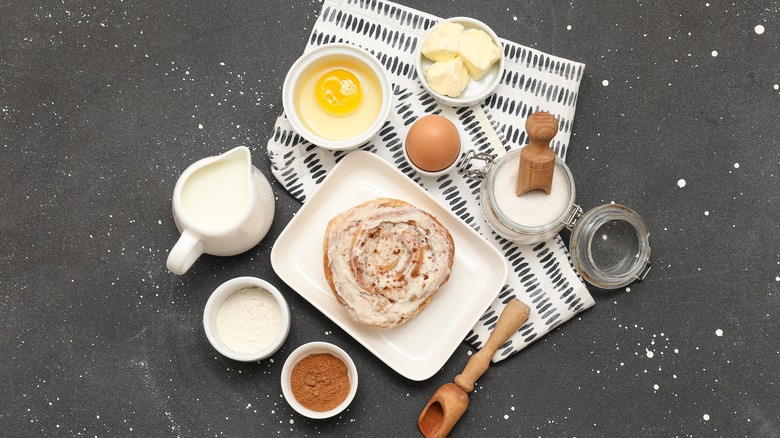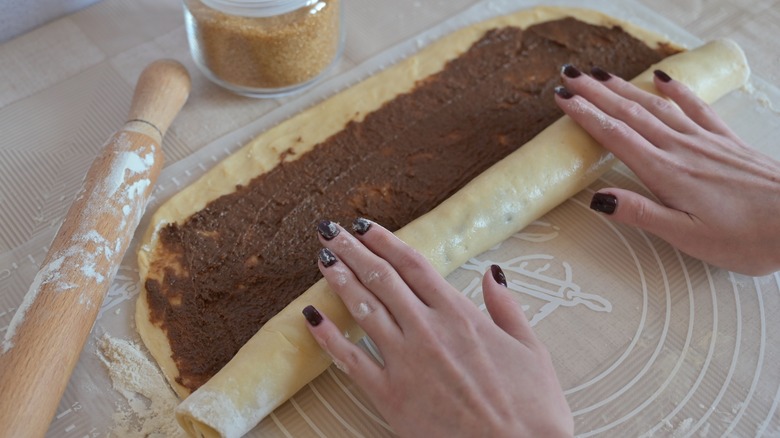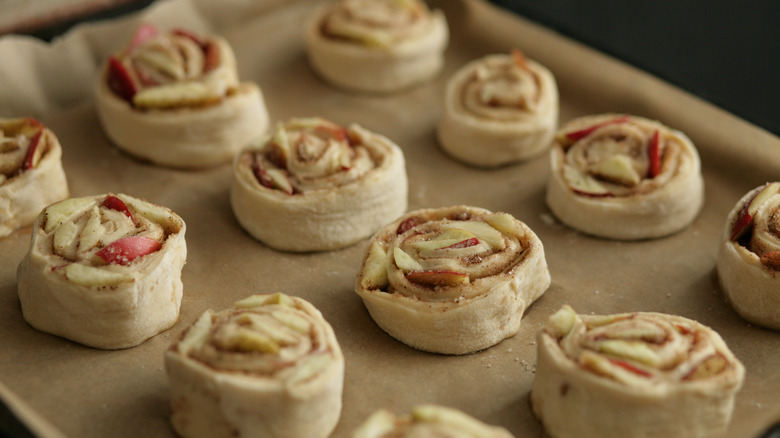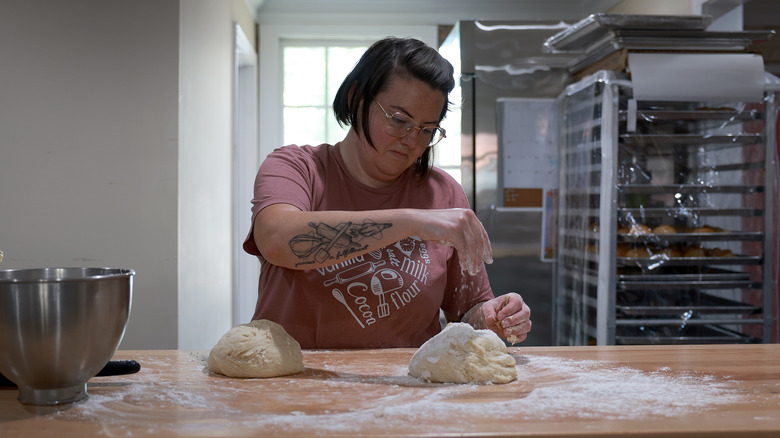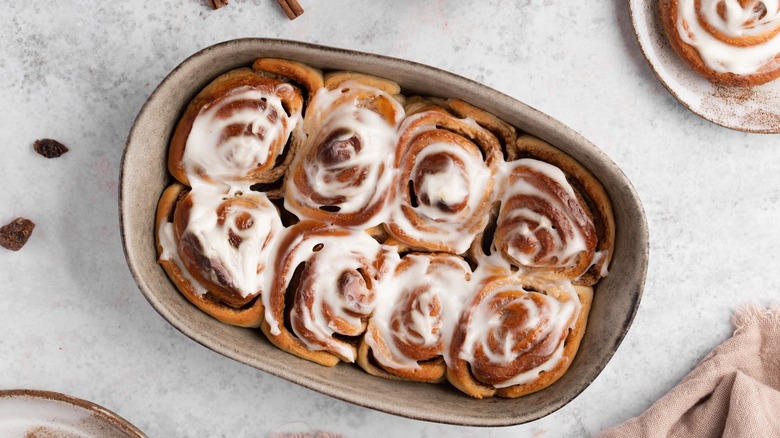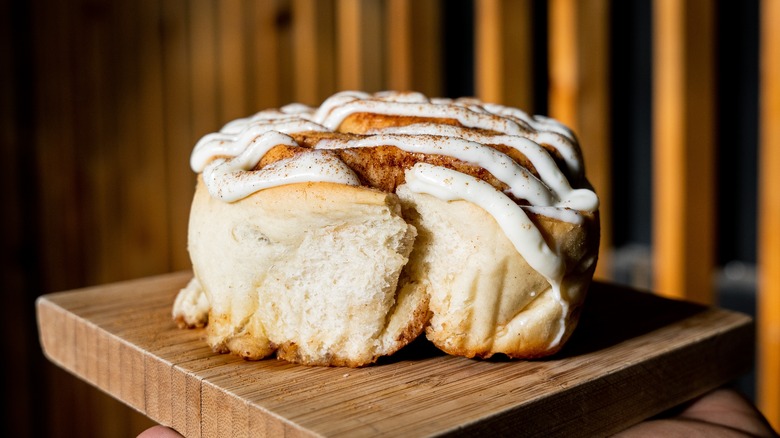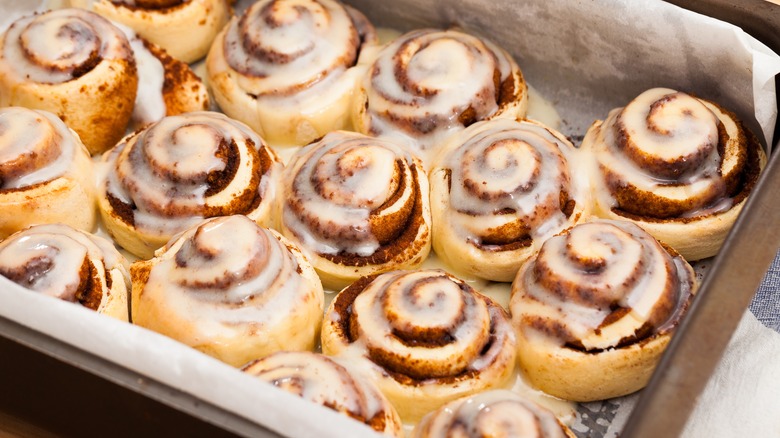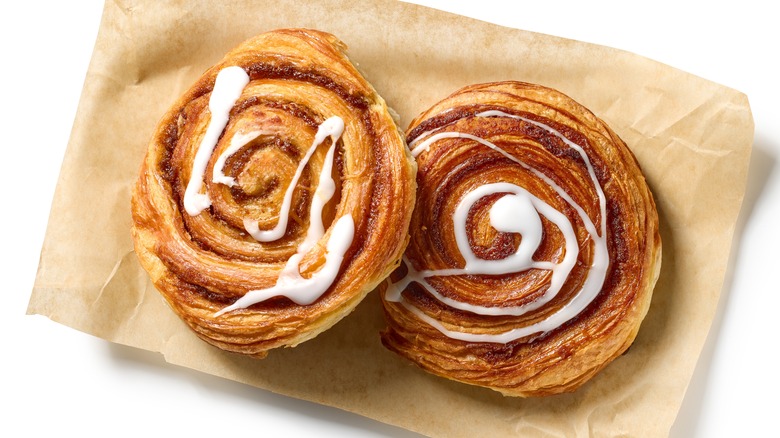Here's Why Cinnamon Rolls Are Always Better From A Bakery
At their best, cinnamon rolls are soft and fluffy with a squidgy center and packed full of flavor. But it's easy to make them dry, bready, or tasteless. So many people try to make them at home, only to be disappointed in the results — this can leave folks wondering why bakery cinnamon rolls are so much better.
As an experienced food writer and recipe developer with professional baking experience, I've made my fair share of cinnamon rolls. I know where they can go wrong, but I also know some tricks of the trade pastry chefs and other professional bakers follow to get them perfectly fluffy with that to-die-for gooey middle. It all starts with an enriched dough, of course, but it's more than just that. Professional bakers consider the details, like what kind of flour to use in the dough and what variety of cinnamon is best. They use quality ingredients and know how to adjust for environmental factors to get amazing results every time.
All this and more is why cinnamon rolls are always superior from a bakery. I'll dive into the details to help you understand how the pros do it. You can use this information to help you bake the ultimate cinnamon rolls. Or maybe you'll just realize how much work it entails and go order from your fave bakery instead.
Bakers consider what kind of flour to use in their cinnamon rolls
When making cinnamon rolls at home, you probably use whatever flour the recipe calls for. This, of course, makes sense. The recipe will have been formulated for that flour type. However, there isn't a right or wrong answer when it comes to flour. Some people believe all-purpose flour is best, others favor bread flour, and then there are those who prefer a mix of both. Professional bakers are aware of the differences and think carefully about the flour they use to get the results they want.
All-purpose flour is lower in protein than bread flour. Protein is what you need for better gluten development, which is why higher-protein bread flour is used to make loaves. It has the strength needed to form a network of gluten that gives bread its distinctive structure. But what does this mean for your cinnamon rolls? Some people are team bread flour, stating that the better gluten formation helps the rolls hold their structure as they rise, resulting in light, fluffy buns. Others believe that bread flour makes cinnamon rolls too chewy and prefer the softness of those made using all-purpose flour.
That's why some pros use a mix of both flour types. This way, the resulting rolls are less chewy and bready than those made with just bread flour, but are lighter and fluffier than those made with just all-purpose flour. For baker-quality results, you might need to experiment to find what you like best.
The dough for bakery-quality cinnamon rolls is enriched
When you get a cinnamon roll from a bakery, the dough is enriched. So, if you've ever tried to make cinnamon rolls with leftover bread dough or pizza dough, it's not the same thing. These rich, slightly sweet doughs make a huge difference to the finished bake.
But what is an enriched dough, exactly? It's one that contains butter, milk, and sometimes egg. The added fat inhibits gluten formation. So, instead of giving you a roll that's tough and chewy, like a rustic loaf of bread, the results are soft and fluffy — more like brioche.
Luckily, it's easy enough to make an enriched dough yourself. Any good cinnamon roll recipe will call for one. But what professional bakers have is the experience and knowledge to know to enrich the dough for the best results. They will have experimented with the perfect ratios of milk and butter, as well as trying egg-containing recipes and comparing them to those without eggs. So, that's why you might not be able to recreate your bakery favorite. A lot of time and effort has likely gone into developing the recipe.
Bakers know exactly how much to mix and knead the dough
One of the mistakes people make with cinnamon rolls is kneading the dough too much. However, under-mixing the dough is another common problem. This might leave you confused, wondering what the cinnamon roll gods want from you. Pastry chefs, on the other hand, are experienced with yeasted doughs. They know just how much to knead them and when to stop for the best results.
Kneading your cinnamon roll dough a little is a good thing. It helps gluten to form, giving the dough structure so it holds its shape as it rises, resulting in a fluffy interior. But overmixing your dough can lead to tough cinnamon rolls. Too much gluten development means your finished bake turns out more like a bread roll than a yeasted pastry. So, it's all about finding the balance between what's too much and what's not enough.
But not everyone agrees with exactly how much kneading that equates to. Some recipes call for mixing the dough until it just comes together, while others want the dough kneaded for 10 minutes or more. Generally, you should start with kneading for around 3 to 5 minutes. The dough should be soft and slightly sticky, but it shouldn't stick to the sides of the bowl if you're kneading it in a mixer. When you're done, the surface of the dough should look smooth.
Professional bakers are well-versed in working with yeast
When you buy cinnamon rolls from a bakery, they're made by professionals who have loads of experience working with yeast. For many home bakers, however, yeast can seem scary. And, admittedly, there are many ways you can go wrong with it.
A common temperature mistake that people make with cinnamon rolls is getting the liquid too hot. A lot of recipes call for warming the milk and adding the yeast to it to proof. But the temperature of the milk is where people often go wrong, making it too hot and killing the yeast. Once the yeast dies, your dough simply won't rise and, if you bake it anyway, you'll get dense, hard cinnamon rolls. Using cold liquid isn't as much of a problem. It won't kill the yeast, but it will cause the dough to rise more slowly.
It can also be tricky learning how long to proof dough, spotting when it either needs more time or has had too much. Plus, you can easily use too much or too little if you're not careful about measuring. Professional bakers are unlikely to fall for any of these mistakes, meaning their cinnamon rolls are better and more reliable.
Cinnamon rolls from a bakery are sometimes made with sourdough
Some of the best cinnamon rolls in the U.S. (and beyond) are made with sourdough. That's not to say that every great cinnamon roll uses a natural starter over packaged yeast, but some of them do. If your favorite bakery version has dough with a complex flavor and a slight tang to it, you might have a sourdough roll on your hands.
The good news is that there are plenty of recipes online for sourdough cinnamon rolls. The bad news — for those who don't already have one — is that you'll need a sourdough starter. These starters are packed with natural yeast and leaven doughs without using commercial yeast. They give baked goods a slightly tangy flavor and chewier texture than ones made with the packaged stuff.
You can buy established sourdough starters, but it's actually simple to make them yourself. Essentially, you just mix together water and flour and leave it for a few days until it captures wild yeast from the air. The instructions are a little more complex than that — you need to feed your starter — but it's an easy process.
Professional bakers think about what kind of cinnamon to use
Did you know there are two types of cinnamon: cassia and Ceylon. Cassia is sometimes referred to as sweet cinnamon while Ceylon is often called true cinnamon. Both are often sold simply as cinnamon, so you might not know which you're getting if you don't check that package carefully, but it makes more of a difference than you might imagine. Professional bakers know this and think carefully about the type of cinnamon to use.
Both cassia and Ceylon come from different trees in the cinnamon family. Ceylon comes only from the Cinnamomum verum tree, native to Sri Lanka and Southern India. Cassia comes from a number of different cinnamon trees, meaning it has a few varieties, the main ones being Chinese, Vietnamese (or Saigon), and Indonesian (or Korintje) cassia.
Cassia is known for its strong, bold flavor. Saigon and Korintje are the most common types found in the U.S. Saigon cassia has a rich, spicy, and sharp flavor while Korintje is spicy but more earthy. Both are common in cinnamon rolls. Though, for reference, Korintje cassia is what Cinnabon uses in its iconic rolls. Ceylon cinnamon is more mild with floral and citrus notes.
Some people believe that cinnamon rolls need the punchy flavor of cassia cinnamon. Others think Ceylon is the superior choice, and is subtle but more complex. Either way, professional bakers are unlikely to use whichever one they happen to find at the store that day. They will have tested varieties side by side to find their favorites.
Bakery-quality cinnamon rolls are made with quality ingredients
The quality of ingredients is what often tips bakery cinnamon rolls over the edge. Ones you make at home with basic ingredients might be perfectly tasty, but they won't reach the heights of those made with more care. When every ingredient is high-quality, you can expect exceptional cinnamon rolls.
Those from a bakery might be made with locally-milled flour and unbleached sugar. But what makes more of a difference to the overall flavor are ingredients like butter, vanilla, and cinnamon. High-end butter tastes significantly different to low-quality butter or margarine. Bakery rolls are likely made with pure vanilla extract rather than artificial essences. The best may even be made with vanilla beans or vanilla bean paste.
Then you have the true star: cinnamon. We've already discussed the different types available, but quality matters, too. Cinnamon from a reputable brand will likely be higher-quality than a generic version. And freshness is important. A new package will taste better than a bottle that's been in your pantry for years. Some top bakeries even grind cinnamon sticks into powder to use in their pastries.
Cinnamon rolls from a bakery might have more filling than you'd add at home
According to The Pioneer Woman, Ree Drummond, the secret to gooey cinnamon rolls is extra filling. This may also be what bakeries provide that your homemade versions are missing out on. It might be as simple as just making some more filling and slathering it in there.
Drummond says that the tick is to add so much filling — cinnamon, butter, and sugar — that when you roll up the dough, it seeps out a bit. That's what gives you more flavor. Not to mention that perfectly gooey, squidgy center that everyone covets.
There's no hard-and-fast rule for how much you should add. You could try making 1.5 times the quantity of filling that a recipe calls for and adjust it up or down from there. The fact is no great bakery is going to be skimping on the filling. So, going big is more likely to make your homemade cinnamon rolls rival the ones from your favorite bakery.
Bakery cinnamon rolls may be proofed overnight
This varies between bakeries, but cinnamon rolls are sometimes proofed overnight. Rather than rising at room temperature, they're proofed more slowly in the fridge, the cold slowing down the action of the yeast. This allows more time for complex flavors to develop, which gives you all-round tastier buns.
There are two ways to proof cinnamon rolls overnight. One is to first proof the dough overnight in the fridge. Then, the next day, you get the dough out of the fridge, give it some time to come to room temperature, and then roll it and form it into pastries, as usual. You'll then leave them to rise for a second time before baking. The other is to do the first rise of the dough alone at room temperature, form the rolls, and then give them their final rise overnight in the fridge. The next day, you get them out of the fridge, let them sit while the oven preheats, and bake them.
Bakeries often use one or the other of these techniques to speed things up in the morning. It cuts out some of the morning prep and proofing time so bakers don't have to get up quite as ridiculously early.
Professional bakers know when dough is properly proofed and can adjust for environmental factors
Yeasted dough is tricky and it can be tough for home bakers to know exactly how long to proof it. Sure, you can follow a recipe, but proofing times can never be 100% accurate. This can lead to over-proofed cinnamon rolls that deflate before being baked and end up dense or tough or under-proofed ones that aren't as light and fluffy as they could be.
Environmental factors are the problem. For instance, dough rises more slowly when it's cold or more quickly when it's hot because yeast is more active in warmer temperatures. Bakers know how to adjust for these environmental factors, whereas the average home baker doesn't.
However, you can learn. You should look for signs that your dough has finished proofing instead of just going by the timings in a recipe. The dough should roughly double in size when it's proofed, though some say it should grow by about 80% rather than fully doubling. When you poke it, the dough should return back to shape slowly, leaving a slight indent.
Cinnamon rolls from a bakery may be iced twice
If you haven't been icing your cinnamon rolls twice, you've been doing it wrong. This is a technique some bakeries use to get the most drool worthy bakes. Of course, you don't have to double-ice them, but it's a simple upgrade that can make a big difference.
This technique involves first icing your buns as soon as they come out of the oven and then doing so again once they've cooled, or just before serving. When you ice hot cinnamon rolls, the frosting melts and seeps into every crack and crevice. However, it means you aren't left with a discernible smear of frosting on the bun when you eat it.
Icing your rolls twice means that the first lot of frosting will sink it, giving you moist, gooey buns. Then, if you ice them when they're cool (or mostly cool if you want to enjoy them while they're still warm), you'll still have a nice layer of frosting on top to sink your teeth into, giving you the best of both worlds.
Bakery cinnamon rolls may have added ingredients for extra moisture
Professional bakers have access to specialist ingredients that we mere mortals don't. They may use these additives in their cinnamon rolls to make them extra-moist. Additives can also keep bakes fresher for longer, so they can still be sold a day or two after baking. It's likely these kinds of ingredients are found in some of your bakery faves.
Instant Clearjel is one such bakery ingredient. It might not sound appetizing, but all it's only a kind of modified cornstarch. Its purpose in cinnamon rolls is to make them softer and more moist. Effectively, it lets the dry ingredients hold onto more moisture without losing structure, so the cooked dough is even fluffier. It can also be mixed with butter to stop it leaking out so you get a gooier interior. Unlike some special ingredients, you can buy it online and use it at home if you want to get bakery-like results.
Bakers may choose a vanilla frosting over cream cheese
Many cinnamon rolls are topped with cream cheese frosting. It's rich, tangy, and delicious. However, some pastry chefs prefer to use vanilla frosting for their cinnamon rolls. This isn't because they don't like cream cheese frosting at all, but just because they're looking to use a lighter touch.
Cream cheese frosting tastes great but it can dominate the pastry. Cinnamon rolls should be all about those warm spices, so you don't want a frosting that takes away from that. This is especially true if you choose to use milder Ceylon cinnamon. A simple vanilla glaze is a great choice here. It's flavorful but it complements the cinnamon rather than fighting with it. If you want it to taste like more than sugar and vanilla, make it more complex with some high-quality butter, evaporated milk, and a mix of white and brown sugars.
Some bakeries opt for a croissant dough
Another variation you might find in some bakeries is the use of croissant dough in place of a basic enriched brioche-style dough. This laminated dough is more complex to make and results in a totally different bun. Rather than soft and fluffy, it's light and flaky.
Croissant dough is essentially a yeasted puff pastry. You start by making a yeasted dough not dissimilar to a bread dough. Then, you gradually add in butter, folding, turning, and rolling the pastry to create layers. It doesn't sound too hard but it's a technique that can take years to perfect. It's not the type of project you'd pick up for a lazy Sunday brunch.
So, if your favorite cinnamon rolls are made with croissant dough, you're left with a couple of options. One: put a lot of time and effort into learning how to make this kind of pastry. Two: get up early and head to your favorite bakery to make sure you snag a cinnamon bun.
